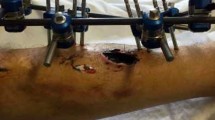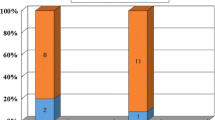Abstract
Besides the surgical debridement of open fractures, also the prophylactic antibiotic therapy has become a standard procedure. Recently it was hypothesized that this strategy may lead to a selection of more virulent and also antibiotic resistant bacteria which subsequently would result in an increased infection rate over years.
In a prospective study bacterial cultures, infection rate and the clinical outcome were examined in 269 open fractures in 230 patients who were admitted to our institution in the years 1993 to 1998. All fractures were treated according to the general principles of open fracture management including antibiotic prophylaxis by the administration of cefazolin 3 time 2g for 3 days starting at the time of surgery. As soon as bacteria were cultured specific antibiotics were applied.
According to the Gustilo classification the majority of fractures were scored as Grade O2 followed by O1, O3C, O3A and O3B. In average 78.7% of all open fractures were tested positive for bacterial contamination initially which clearly correlated with the fracture type (24.5% in O1 fractures and 86.8% in O3C fractures ). This bacterial contamination resulted in a mean osteitis rate of 8.2%, again depending on the fracture type. In O1 fractures no case of osteitis was noted, whereas in O3C fractures the osteitis rate was as high as 23.7%. In 21.3% of all open fractures no bacilli were recovered initially but all of these were tested positive in subsequent cultures. But only 3.4% out of these patients sustained a soft tissue infection and no osteitis. The mixed bacterial flora was dominated by Staphylococcus aureus (52.8%), followed by Escherichia coli and Enterobacter (32.5%), Streptococci (26.0%), Pseudomonas (17.1%) and Proteus (1.6%). Other mainly environmental bacteria were present in 30.1%. Despite specific antibiotics the bacterial flora shifted during therapy in the majority of all infections in favor of Staphylococcus aureus, Enterobacter and Pseudomonas. Compared to data in the literature and our institution the infection rate in open fractures based on this study slightly increased especially in O3B and O3C fractures but not yet significantly.
There seems to be a shift of cultured bacteria towards hospital acquired pathogens which may explain the increased infection rate, as the percentage of initially bacterial contaminated and not contaminated open fractures stayed almost the same over the years.
Similar content being viewed by others
Author information
Authors and Affiliations
Additional information
Submitted: March 21, 2000; revision accepted: May 15, 2000
Rights and permissions
About this article
Cite this article
Seekamp, A., Köntopp, H., Schandelmaier, P. et al. Bacterial Cultures and Bacterial Infection in Open Fractures. Eur J Trauma 26, 131–138 (2000). https://doi.org/10.1007/s000680050011
Issue Date:
DOI: https://doi.org/10.1007/s000680050011




